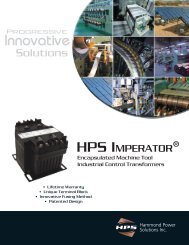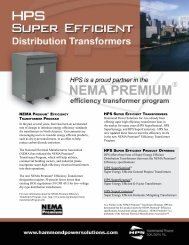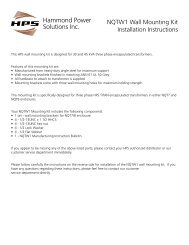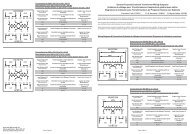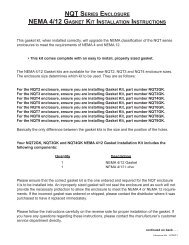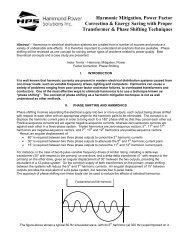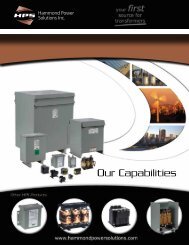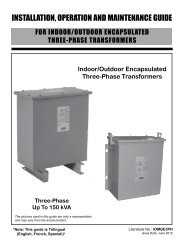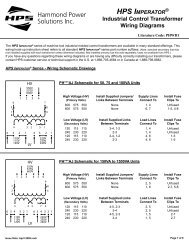installation, operation and maintenance guide - Hammond Power ...
installation, operation and maintenance guide - Hammond Power ...
installation, operation and maintenance guide - Hammond Power ...
You also want an ePaper? Increase the reach of your titles
YUMPU automatically turns print PDFs into web optimized ePapers that Google loves.
Page 14 walls or reflecting surfaces at least 10’ [3m]away from all sides of the transformer.Transformers are frequently installed in more confiningelectrical rooms, <strong>and</strong> additionally, when connected tothe load, will exhibit higher sound levels than st<strong>and</strong>ard.Excessive noise can be caused by: high input voltage high frequency unbalanced loads excessive load current voltage <strong>and</strong> current harmonics fromnonlinear loads loosened core clamps hardware or enclosures loosened due toshipping or h<strong>and</strong>ling shipping plates are not removed anti-vibration pads are not installed transformer locationTransformers will exhibit higher than normal soundlevels if installed on suspended floors that mayresonate. It is a good practice to install power units onthe ground floor or basement level to avoid suspendedfloors. Vibration dampeners or spring isolators arerecommended to attenuate sound levels. Additionally,flexible connectors should be installed betweenthe bus bars <strong>and</strong> other equipment to avoid vibrationtransfer.Transformers installed in close proximity to each othercan also experience a resonant frequency betweenthem that will result in higher than normal soundlevels.(3) Reduced or Zero VoltageLoose connections on transformer terminals orterminal boards, broken lead wires or shorted turns arepossible sources. As well, reduced output voltage maybe from an incorrectly selected tap position.(4) Excess Secondary VoltageCan be caused by higher input voltage or an incorrecttap position.(5) Smoke from TransformerUncured or excessive varnish or encapsulationmaterial burning clear on start-up may cause smoke.This is usually not a reason for either concern or along term risk for the transformer.Smoke <strong>and</strong> or fumes on start up is common <strong>and</strong> is theresult of oils <strong>and</strong> lubricants used in the manufacturingprocess. The smoke is considered an irritant <strong>and</strong>should be temporarily ventilated. It is not a long termhealth risk.(6) High Core LossCauses are high input voltage <strong>and</strong>/or lower frequency. gap in core(7) Burned Insulation or Insulation FailureWith evidence of burned insulation, check for thefollowing: continuous overload condition excessive harmonics overheating due to ventilation lightening surge switching or line disturbance broken leads or arresters damaged terminals or terminal boards shorted turns or mechanical damage contamination (insulation failure)If transformer cores show evidence of overheating <strong>and</strong>discoloration, insulation near the core may also appeardiscolored. Very high core temperatures are causedby:



